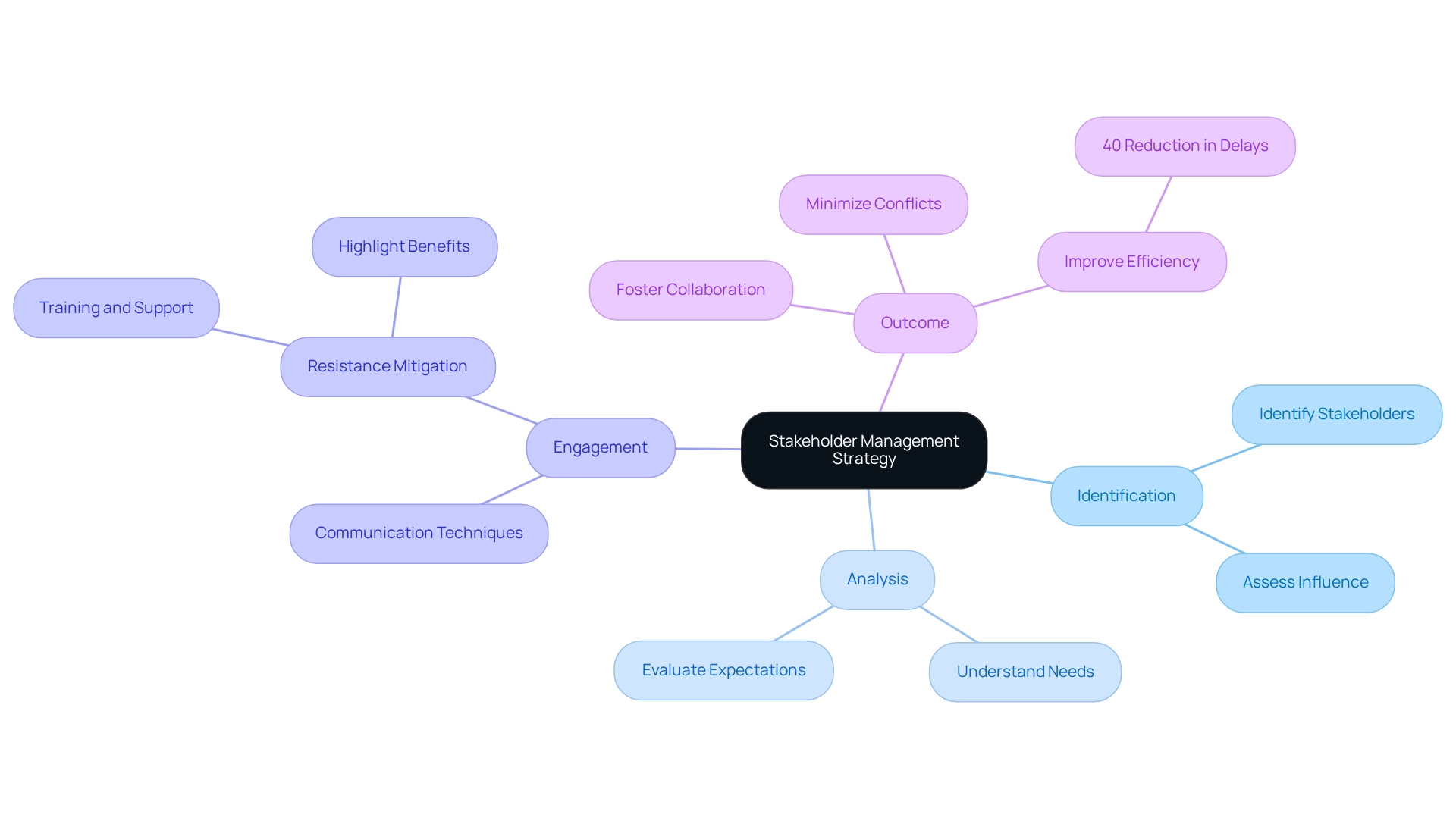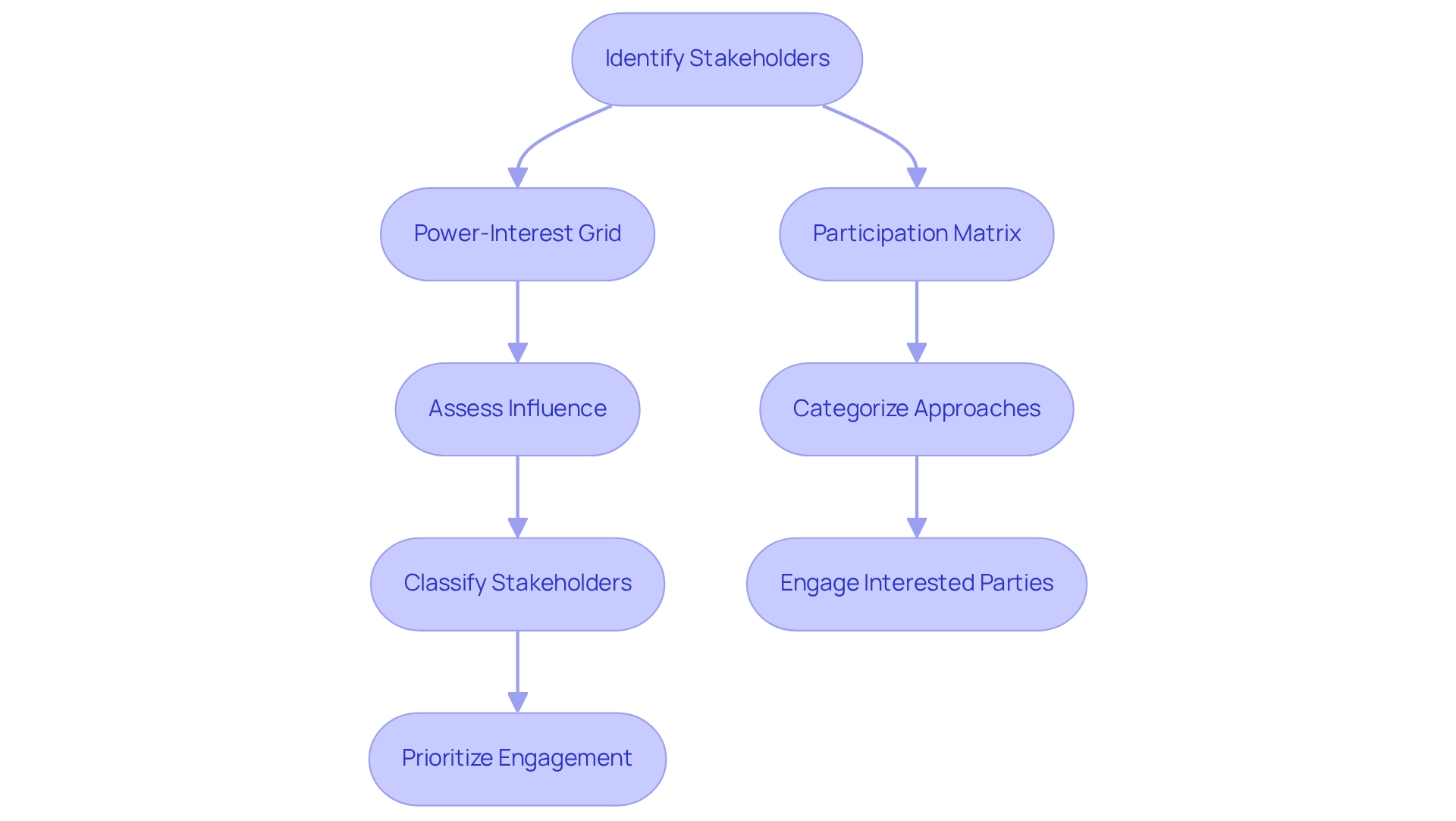Overview
This article presents a five-step process for developing an effective stakeholder management strategy within project management. It underscores the necessity of:
- Identifying stakeholders
- Analyzing their influence and expectations
- Crafting a communication strategy
- Continuously monitoring and adapting the approach
Such a framework is substantiated by evidence indicating that proactive stakeholder engagement can significantly minimize project delays and enhance overall project success. By fostering collaboration and addressing concerns early, project managers can ensure a smoother path to achieving their objectives.
Introduction
In the intricate landscape of project management, the role of stakeholder management emerges as a pivotal factor in achieving success. As projects evolve, the need to identify, engage, and understand the various individuals and groups impacted becomes increasingly critical. Effective stakeholder management not only aligns diverse interests but also fosters collaboration, reduces conflicts, and ultimately drives project outcomes.
Moreover, statistics reveal that poor engagement can lead to a staggering 70% of project failures; thus, the importance of a strategic approach cannot be overstated. This article delves into the essential components of stakeholder management, including:
- Identifying key players
- Analyzing their influence
- Developing tailored communication strategies
- Monitoring engagement
These components equip project managers with the tools necessary for navigating the complexities of stakeholder dynamics.
Define Stakeholder Management in Project Context
The stakeholder management strategy in project management is a systematic process that involves identifying, analyzing, and engaging individuals or groups with a vested interest in or influence over a project. Understanding their needs, expectations, and potential impact on success is crucial. An effective stakeholder management strategy in project management ensures alignment with objectives, fostering collaboration and minimizing conflicts. By recognizing the importance of stakeholders, managers can proactively address issues and leverage support, leading to enhanced outcomes.
For example, the case study titled 'Resistance to Change' demonstrates how stakeholders may resist new initiatives, often stemming from fear or insufficient information. By applying change management techniques—such as training and support—managers can mitigate this resistance and highlight the benefits of the initiative to stakeholders. Moreover, as Tan Dang, a Content Writer at Orient Software, asserts, 'Communication is also crucial in achieving a climate of understanding in terms of expectations, managing issues arising, and promoting cooperation.' This underscores the vital role of communication in stakeholder management.
Data indicates that companies focusing on stakeholder engagement experience a remarkable 40% reduction in delays, directly contributing to improved efficiency and success. Consequently, implementing a stakeholder management strategy in project management is not merely beneficial; it is essential for achieving project goals.

Identify Key Stakeholders and Their Interests
Recognizing important participants is a key aspect of the stakeholder management strategy in project management, which begins with compiling a comprehensive list of individuals and groups involved in or affected by the project. This list should encompass:
- Team members
- Clients
- Suppliers
- Regulatory bodies
Once compiled, it is crucial to organize participants according to their interests and influence. Tools such as participant maps or influence-interest grids can effectively visualize their roles and relationships.
Involvement is critical; conducting interviews or surveys can yield valuable insights into contributors' expectations and concerns. This proactive approach not only clarifies who your interested parties are but also illuminates their needs and priorities, which are crucial for a successful stakeholder management strategy in project management. Notably, studies indicate that insufficient involvement of interested parties results in approximately 70% of initiative failures, underscoring the significance of this process. By understanding the dynamics of participant mapping and engagement, managers can substantially enhance their effectiveness through a stakeholder management strategy in project management and foster stronger relationships throughout the initiative's lifecycle.

Analyze Stakeholder Influence and Expectations
Once parties are identified, it is crucial to assess their impact and expectations through a power-interest grid. This tool effectively classifies participants based on their degree of influence on the initiative and their interest in its outcomes. High-power, high-interest parties warrant prioritization for engagement, whereas low-power, low-interest groups may require less frequent communication. As the Project Management Institute (PMI) asserts, "the project management team must … manage and then influence those expectations to ensure a successful project." Moreover, consider employing a participation matrix to categorize approaches for engaging interested parties based on their roles and requirements.
Conducting interviews or surveys can yield valuable insights into the expectations and concerns of interested parties. Understanding these dynamics allows managers to efficiently tailor their stakeholder management strategy in project management, ensuring that essential participants remain informed and involved. For instance, a case study on an offshore wind farm initiative illustrated how a well-structured participant engagement strategy, developed through comprehensive analysis, mitigated opposition and fostered collaboration, ultimately contributing to the endeavor's success by aligning with the power-interest grid analysis. By leveraging these tools and actively involving key participants, project managers can adeptly navigate complex dynamics by implementing a stakeholder management strategy in project management, ensuring that essential contributors are informed and engaged throughout the project lifecycle.

Develop a Tailored Communication Strategy
Developing a customized outreach plan is essential for a stakeholder management strategy in project management, starting with the establishment of clear goals and the selection of the most effective channels for each group of interested parties. Identify the key messages to convey and determine the frequency of correspondence. Utilize a variety of formats—such as emails, newsletters, meetings, and reports—to accommodate diverse preferences and enhance engagement. It is essential to encourage mutual dialogue, allowing participants to provide input and express concerns. Consistently evaluate and improve the approach for interaction based on stakeholder feedback to ensure continuous involvement, which is essential for an effective stakeholder management strategy in project management and to address any emerging issues.
Research indicates that poor information exchange can cost organizations between $10,000 and $55,000 per employee each year, underscoring the financial advantages of investing in efficient interaction strategies. Moreover, with 69% of workers indicating they would exert more effort if valued, prioritizing interaction can significantly enhance employee satisfaction and retention, both of which are crucial for sustaining healthy margins in today's competitive environment. Notably, 55% of organizations prioritize margins, while 54% emphasize employee satisfaction and retention, highlighting the dual importance of effective interaction in achieving both operational efficiency and workforce stability.
As Marija Kojic observed, 66% of knowledge workers and 72% of business leaders desire their company to provide improved tools for interaction, emphasizing the necessity for customized approaches. In addition, ensuring accessibility for team members across different linguistic backgrounds and time zones is vital for fostering inclusive communication.

Monitor and Adapt the Stakeholder Management Strategy
Monitoring the effectiveness of your management strategy is crucial; it involves regular assessments of engagement levels and satisfaction among all involved parties. Leverage real-time analytics from your client dashboard to evaluate how well participants feel informed and engaged. This data-driven approach not only streamlines the decision-making process but also empowers your team to take decisive action based on valuable input from stakeholders.
Regularly employ surveys, feedback sessions, and performance metrics to consistently gauge business health and participant sentiment. Be prepared to adapt your strategy based on this feedback; if specific parties raise concerns or if circumstances change, adjust your communication techniques or engagement methods accordingly.
This proactive stakeholder management strategy in project management ensures that relationships with stakeholders remain robust and that their needs are continuously met throughout the project.
For further insights on enhancing your stakeholder management strategy, contact SMB Turnaround at +1 (239) 428-9074 or visit us at 3200 Bailey Ln, Naples, FL 34105.

Conclusion
Effective stakeholder management is essential for the success of any project, as it directly influences project outcomes and team dynamics. By systematically identifying and engaging stakeholders, project managers can align diverse interests and foster collaboration. The importance of understanding stakeholder influence and expectations cannot be overstated; tools like power-interest grids and stakeholder maps enable managers to prioritize engagement efforts strategically.
Tailored communication strategies play a crucial role in maintaining stakeholder relationships. By establishing clear objectives and utilizing various communication channels, project managers can ensure that stakeholders remain informed and feel valued. This two-way communication fosters trust and cooperation, which are vital for minimizing resistance and enhancing project efficiency.
Moreover, the ongoing monitoring and adaptation of stakeholder management strategies are key to sustaining engagement throughout the project lifecycle. By regularly assessing stakeholder sentiment and being responsive to their needs, project managers can navigate complexities effectively, leading to improved project outcomes and reduced risks of failure. In a landscape where up to 70% of project failures can be traced back to poor stakeholder engagement, prioritizing these strategies is not just beneficial but necessary for achieving project success.
Frequently Asked Questions
What is stakeholder management in the context of project management?
Stakeholder management is a systematic process that involves identifying, analyzing, and engaging individuals or groups with a vested interest in or influence over a project. It focuses on understanding their needs, expectations, and potential impact on the project's success.
Why is stakeholder management important in project management?
An effective stakeholder management strategy ensures alignment with project objectives, fosters collaboration, and minimizes conflicts. By recognizing the importance of stakeholders, managers can proactively address issues and leverage support, leading to enhanced project outcomes.
How can resistance from stakeholders be managed?
Managers can mitigate resistance from stakeholders by applying change management techniques, such as providing training and support. Highlighting the benefits of the initiative can also help alleviate fears and insufficient information that may lead to resistance.
What role does communication play in stakeholder management?
Communication is crucial in achieving a climate of understanding regarding expectations, managing arising issues, and promoting cooperation among stakeholders. Effective communication helps to build relationships and address concerns.
What are the benefits of focusing on stakeholder engagement?
Companies that focus on stakeholder engagement experience a remarkable 40% reduction in delays, which contributes directly to improved efficiency and success in project management.
How can key stakeholders be identified?
Key stakeholders can be identified by compiling a comprehensive list of individuals and groups involved in or affected by the project, including team members, clients, suppliers, and regulatory bodies.
What tools can be used to organize stakeholders?
Tools such as participant maps or influence-interest grids can effectively visualize the roles and relationships of stakeholders, helping to organize them according to their interests and influence.
Why is involvement of stakeholders critical in project management?
Involvement of stakeholders is critical because insufficient engagement can lead to approximately 70% of initiative failures. Understanding their needs and priorities is essential for a successful stakeholder management strategy.




